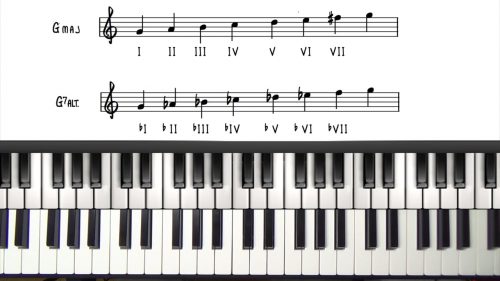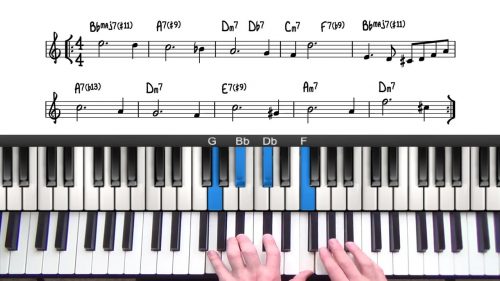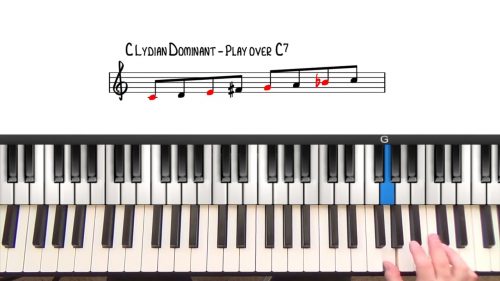Blue In Green Tutorial
Blue in Green is the third track on Miles Davis’ album ‘Kind Of Blue’ which is the best-selling jazz album of all time. The album is worth checking out if you haven’t already.
The 10-Bar Form
The form of Blue in Green is very unusual. The 10-bar form is much shorter than most jazz standards, and is even shorter than a 12 bar blues. Because the form just contains 10 measures, it is usually repeated many times in a performance.
Applying Altered Harmony
In this lesson we explore and apply altered harmony and chord alterations. The melody contains many of the interesting upper extensions and alterations which makes this a great tune to apply the theory.
Lesson Downloads
-
“Blue In Green” Transcription File Type: pdf
-
“Blue In Green” Lesson Notation File Type: pdf
Practice Tips
-
Notice that the melody contains lots of the upper extensions and alterations.
-
When playing jazz standards, analyse the melody notes in terms of scale degrees relating to the underlying harmony.
-
Over time, this will help you to choose appropriate chord voicings quickly and easily.
-
Learn and memorise the altered voicings covered in this tutorial.
- Check out the many Bill Evans recordings of this tune for additional inspiration.








Love this lesson. It used to be hard to play this song because it made me kind of sad and the fingering didn’t feel natural. Now I love to play it. Can’t wait to get to part 2 of it. Thanks again.
That’s awesome to hear Adam! There are some unusual voicings and big stretches which can feel uncomfortable when first starting out with this tune. I think you will enjoy part 2 as we look at some important improvisation concepts that can be applied to any jazz standard.
which book is this? the new real or the real real book?
Real book One
There’s an interesting back story about this. Miles Davis took credit for it, but years later during a recorded interview by Marion McPartland, Bill Evans said he composed it.
Yes the chords have Bill Evans written all over them, perhaps Miles had some say in the melody. Many of the real books reference Miles as the author and so I included here it for easy reference. I’m aware that Bill Evans often spoke vehemently of Blue In Green being his own composition. Thanks for the great comment :-)
Eliane Elias plays a stunning arrangement on Something for you, her Bill Evans tribute album
Thanks TJ. I’ll check out that.
Cheers,
Hayden
There are people saying that this is a bill evans composition!Is that true?
Hi Ivan, yes Bill Evans said in an interview that he composed the tune. The chords have Bill written all over them. The RealBook says Miles Davis, so I decided to use that to avoid confusion. Cheers! PianoGroove
Thats Awesome thank for replying! I was thinking that we can create an official whatsap group for all members of the comunity!That would be really cool.What i dont know if that Idea is compatíble with an online bussiness .It would be great for instant interaction, vídeos ,áudios knowledge or something to look quicky when we are waiting for something in our daily busy lives ..The problem is that a whatsap group can easly get out of control só it would need some good administrators
Hey Ivan – great idea, and I think we can take this somewhere special. You have the cogs in my brain turning.
As you highlight, WhatsApp can easily get out of control with just 5 people in a group.
It would be very difficult with all our students.
Leave it with me Ivan… and keep sending me great ideas.
We will make something special with PianoGroove, and revolutionise online learning.
Cheers!
Hayden
Olso it was interesting what you did there at the 14.50 minute.Playing a chord to sound like a rootless voicing..That one caught my atention !Só the trick is to play Both the root and the 7 with a minor second interval ?
Yes exactly Ivan, that could be classified as a cluster voicing, playing notes close together at the bottom of the voicings gives you a nice sound. Having the 7th on the bottom creates a ‘crunch’ and unique texture. Beautiful!
Check out this tutorial next Ivan: pianogroove.com/jazz-piano-lessons/cluster-voicings/
You then get into the whole concept of ‘intent’ ie. you can imply a tonality or chord with just one or 2 notes.
Basically you can do anything. Jazz is freedom!
Cheers,
Hayden
Going to check that out..this one was a busy só i m more slow than before lol.. bit i m taking action again
Hi Hayden,
I have a simple question :)
In the fourth bar does the F7B9 chord falls on the fourth beat of the measure?
And the D note in the melody falls down in the third beat of the measure?
I’m playing tunes with counting to (myself 1 and 2 and)… in order to a better natural feeling for rhythm, I found out that counting to my self verbally to be very efficient way to feel the rhythm.
Thanks.
Hi Ariel,
According to the lead sheet, the melody note falls on the 2nd beat of the bar. The F7b9 chord falls on the 3rd beat of the bar.
As with all jazz standards, both the melody and the harmony are open to interpretation by the performer/arranger.
A good exercise would be to listen to a few of the famous versions and count where the melody and chords are being placed in the bar. That would give you a better understanding of how the tune is commonly played.
And yes counting is a great way to keep you in time. Even better using a metronome because then there is no room for human error! I’ve met many musicians who advocate playing with a metronome 100% of their practice time.
I must admit that I find it hard to stick to this but I can see its benefits. The idea is that we become completely ‘calibrated’ with the click.
A final note is that playing accurately at slow tempos with a metronome is harder than fast tempos. Give it a try with this tune, and then pick a faster medium/up tempo tune – and you will see what I mean!
Enjoy the lessons.
Cheers,
Hayden
Great lesson, thanks. I really like the adding inner movement with a LH voicing with different alterations, will be sure to use that! Could you upload the lead sheet used in the video please? Thanks
Hi Kester,
I have added a new download containing the exact
I’m glad you enjoyed the lesson and yes the inner voice movement is a beautiful device that we can use in left hand voicings and also 2 handed voicings, check out this lesson where we explore inner voice movement over major, minor, and dominant chords: pianogroove.com/jazz-piano-lessons/adding-inner-voice-movement/
Cheers,
Hayden
Hi Hayden,
Sorry if you covered this, but you’re able to sub Bbmaj7 in for Gmin because it’s the relative major since it’s a 6th below?
Thanks!
Hi Theo 👋
Yes that’s exactly right G- and Bbmaj are relative, they share a lot of similar chord tones, and they can often be interchanged.
It’s worth pointing out that the G-13 is in fact the original chord here, and the Bb7#11 is the reharmonisation.
Both chords have an interesting colour and texture and we can choose between them. The form of this tune is very short and so we can alternate these voicings with each chorus.
Cheers,
Hayden
Looking at the arrangement with the three staves:
measure seven has the Kenny Baron voicing ‘superimposed’ with both hands on top of each other. I couldn’t find any comfortable way to play this. However when I rewrote it it was simply a stacked thirds Dm7 (9 11) D F A in the bass clef C E G in the treble clef!! Did you write it this way for us to discover this??
Also in measure 10 I think the G# should be C# … at least that’s what I’ve seen in lead sheets that I have.for Blue In Green.
Hi John,
I’m can’t seem to find the bar you are referring to in the PDF file, but to explain a little about the D-11.
There are a 2 useful voicings for the minor chord with the 11 in the melody, the first is simply stacked 3rds from the root to the 11. For a bigger voicing we can play the “Kenny Barron Voicing” which is 2 stacked 5ths in the left hand, a minor 2nd interval, and then 2 stacked 5ths in the right hand.
For measure 10 yes that can certainly be voiced with the C# which makes the chord D-maj7. As a rule of thumb, we can replace the minor 7 with the major 7 on minor chords to access that minor-major flavour. I would be cautious about how often you use it, but it can be a very powerful device. Yes you are correct and that measure is often voiced as a minor major chord in popular recordings of the tune.
I hope that helps!
Cheers,
Hayden